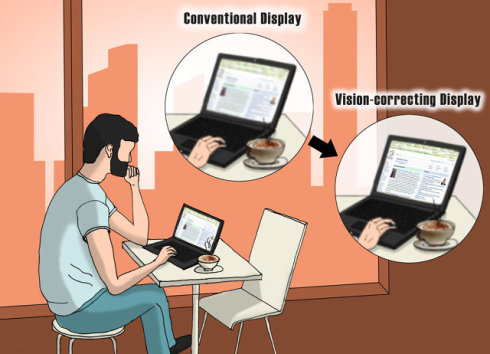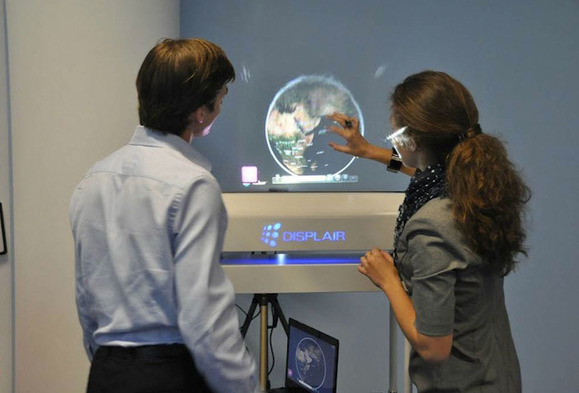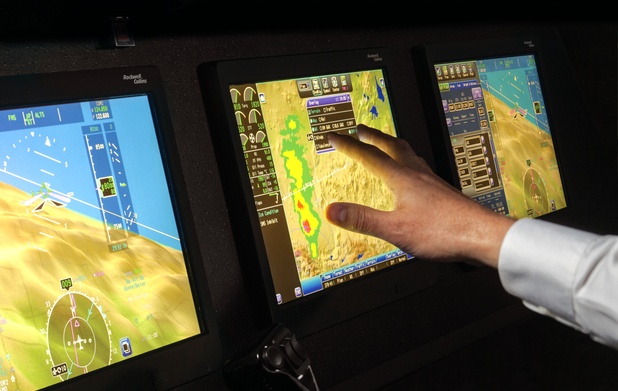Display Technology News Roundup 12.17.2015

Image via Cineplex Digital Solutions
Display Alliance is sponsored by Smarter Glass (www.smarterglass.com), a leading distributor and solutions provider with nearly 15 years specializing in the global LCD display industry and PCAP touchscreens. This blog is an open resource for the display industry and welcomes content and sponsorship from readers. Contact us to discuss how we can work together on Display Alliance. For display panels, visit the Smarter Glass display database to search and compare thousands of panels side-by-side.
How art and interactivity are painting a new digital signage experience ""People are accustomed to being presented with information and data and often have expectations about how it is delivered," said Matt Arnold, lead engineer for Second Story, part of SapientNitro. "Displays which employ an unusual or even artistic approach to displaying information can have an emotional effect on viewers, resulting in a more impactful and lasting experience." In some creative use-cases, Arnold said, information can be delivered to viewers in an ambient way that "envelops" them without their explicit awareness. "If you want to engage an audience through displays, you first must recognize that the display canvass is only a small part of a wider context of information that they are witnessing. When they are idle, the displays which blend into the environment and provide an ambient layer of story and information have more impact than those that are 'always on,'" he said. "When content reacts to the presence of viewers or adjusts with the context of their surroundings, it becomes more relevant to viewers. Displays that show the same messaging regardless of their environment can become background 'noise' and ignored by your audience." The human brain, which makes up only 3 percent of body weight but eats up to 20 percent of body energy, is hardwired to conserve energy wherever possible, said Ed King, vice president of strategy at MaxMedia, and that means it usually takes the path of least resistance. "When confronted with words, numbers or icons/graphics, the brain always looks for the 'quick answer.' By creatively visualizing data, wayfinding and other digital signage, retailers stand a better chance of communicating their message more efficiently and effectively to customers," he said." via Digital Signage Today
2017 Mercedes-Benz E-Class Has All The Display Screens "Mercedes-Benz gave everyone a look inside its new 2017 E-Class by virtue of a video (watch Video) released last week, and it’s covered in digital displays. As for the exterior, the manufacturer hasn’t shown us what it looks like just yet—but might have accidentally given a hint. ...As far as what’s officially inside of the new car, the E-Class features more video displays and less actual buttons. It’ll even mark the first time that a car has touch-sensitive control buttons on the steering wheel, which respond to finger swipes—similar to the functions on a smartphone—to control the car’s infotainment system. If the driver doesn’t want to swipe, he or she can switch the car over to respond to voice commands. Even for a person who likes options, this car has a ton of options." via Jalopnik
Will Apple Cause the Death of LCD Displays? "If Apple does leap, the broader choice of suppliers will be one factor influencing its choice. While Samsung, its arch-rival in smartphones, controlled the OLED field, it had a real incentive to stay away from that technology, rather than increase the amount of business it gives to the Korean firm (which already manufactures many of its processors and is a major memory vendor). So Apple used its power to support other companies in pushing LCD technology to its limits in terms of screen resolution, color intensity, performance and so on. If it moves to OLED – as it has already for the Apple Watch – it will hit a whole supply chain. One of the Japanese firms which saw its value fall on the reports was Minebea, which makes backlights for LCDs, while another was Nitto Denko, a supplier of film. In general, LCD displays use more components than OLEDs, because they need color filters and backlights, so the industry shift away from them, as the OLED market gets more competitive and affordable, will be a negative for many of these specialized technologies." via Rethink Research
Toshiba Will End TV Production "Toshiba’s retreat from TV manufacturing highlights the company’s growing focus on nuclear power infrastructure and other business-to-business operations and a shift away from its consumer businesses. It also marks the increasing relapse of Japanese manufacturers in the global home electronics market, losing ground to overseas competition. Toshiba in 1959 became the first company in Japan to produce a color television. The TV business has since been a centerpiece of its operations, best known in recent years for the Regza series of liquid crystal displays introduced in 2006. But the division has been bleeding money since 2011 in the face of intensifying competition from South Korean and Chinese manufacturers." via The Japan Times
Display database for engineers Search thousands of display panels by multiple characteristics and compare results side-by-side using the display database multisearch.
Which Is the Better Display? Quantum Dot vs OLED "QDs are currently reliant on a backlight, the deep black accuracy and contrast ratio will still suffer from similar drawbacks as existing LCD displays. Therefore, OLED should still win out when it comes to contrast and high dynamic range imagery, as it can switch off pixels for a pure black dot, but QD displays will still see a boost in brightness over traditional LCD. This leads us onto viewing angles, an area that OLED again boasts superiority over LCD displays and this is unlikely to change much with the introduction of Quantum Dot displays. Because backlight based displays require a filter layer rather than producing light directly on the surface, some light is blocked when you don’t look at the display from head on. While perhaps not likely to be a major problem on your small mobile phone, Quantum Dot displays won’t match OLED’s viewing angles until designs come along that eliminate the need for a backlight." via Android Authority
New Material Could Make Touchscreens More Affordable "ITO is a transparent conductor used in more than 90 percent of the display market and has been the dominant material for the past 60 years, said researchers from Pennsylvania State University. In the last decade, the price of indium has increased dramatically, and displays and touchscreen modules have become a main cost driver in smartphones and tablets, making up close to 40 percent of the cost. In other words, while memory chips and processors get cheaper, displays get more expensive from generation to generation. The Penn State team has reported a design strategy using 10-nm-thick films of an unusual class of materials called correlated metals. In most conventional metals, such as copper, gold, aluminum or silver, electrons flow like a gas. In correlated metals, such as strontium vanadate and calcium vanadate, they move more like a liquid. The electron flow produces high optical transparency along with high metal-like conductivity, the researchers said. " via Photonics.com
New 360-Degree 3D Hologram Imaging Technology "Korean scientists developed a hologram display technology that can realize holograms in 360-degree three-dimensional (3D) color image, which often appears in science fiction films such as Star Wars and Minority Report. It will be used as a core technology that allows users to watch hologram images in smartphones or ushers an age of hologram TV. The Electronics and Telecommunications Research Institute (ETRI) announced on Dec. 2 that it developed a “tabletop holographic display” technology that reproduces 360-degree 3D hologram at a size of 3 inches. A Hologram produces 3D photographs by using interference and diffraction properties of light waves. At present, commercialization is not possible due to technical limits. Only MIT in the U.S. and Japan's National Institute of Information and Communications Technology (NICT) have demonstrated hologram technologies that enable users to view images from within an angle of 20 degrees. The ETRI said that real hologram technology uses diffraction of light waves, unlike fake hologram that is used in hologram shows." via BusinessKorea
India's First 'Display Variant' Debit Card "Axis Bank today said it has launched a 'display variant' debit card which does away with the hassles of generating one time password (OTP) over SMS while transacting. The card, which is being made available for high-value NRE customers, has an embedded EMV chip, a display screen and a touch-sensitive button which helps generating the OTP on the card itself. "This OTP, in conjunction with the user ID and password, allows the customer to transact on internet banking without having to wait for OTP delivery via SMS or email," a bank statement said, adding that it is the first lender in the country to offer the facility." via Business Standard
Do you have content to share with Display Alliance? Anyone can post press releases, white papers, commentary, videos, and more in the open section.
How Can Industrial Digital Signage Lead to Increased Productivity? "But what about signage in the industrial space? How can these communication devices enhance the quality of operations at plants, warehouses and other similar sites? What advice should you be giving industrial customers on how to make best use of digital signage? Typically, hundreds or thousands of employees work at industrial plants, so communicating to everyone across the board is a tall order. Netpresenter, a Netherlands-based signage provider with locations in the United Kingdom, Germany and the United States, says its multichannel solutions improve safety, enhance internal communications, and foster employee engagement. Here are several ways that can happen: 1) Put key performance indicators (KPIs) front-and-center near production lines - Industrial plants can go a long way toward helping workers keep tabs on actual, and target production numbers by posting them in real time on digital displays. Signs can also feature output data, as well as comparisons against a set target or previous period to keep workers motivated to do their jobs." via Channelnomics
HP Inc. Is Bringing Its Giant Virtual Reality Display Into Healthcare "HP’s VR machine, called Zvr, isn’t your typical VR hardware like the Oculus Rift headset. Rather, it’s a 23.6-inch display connected to four cameras that track its user’s head movements. A set of glasses turns images into 3D, and a stylus allows the user to move 3D objects around and poke at them. Now HP hopes to bring the Zvr into the medical world in collaboration with medical software upstart EchoPixel. The Mountain View, Calif.-based startup makes 3D medical visualization software that turns diagnostic scans into 3D models. Those 3D projections of, say, an organ, can then be studied in VR. The hardware-software partnership is intended to be used to diagnose ailments or assist in planning operations. Typically, EchoPixel CEO Ron Schilling explained, a doctor sits in front of a computer looking at multiple medical imaging scans and tries to make sense of them in 2D. EchoPixel’s pitch is that turning these scans into 3D models will help doctors identify overlooked issues. For example, 3D scans could make it easier to identify a polyp, abnormal tissue growth, in an organ." via Forbes
Apple reportedly opens ‘secret’ display laboratory in Taiwan "Apple has opened a “secret laboratory” in Taiwan to develop new display technologies, according to a new report, citing sources who are familiar with the company’s plans. The facility employs “at least” 50 engineers who are working to build better displays for iPhone and iPad. “Apple has recruited from local display maker AU Optronics Corp. and Qualcomm Inc., which used to own the building, the people said,” reports Bloomberg. “Apple began operating the lab this year as it aims to make products thinner, lighter, brighter and more energy-efficient.” Apple is thought to be working on more advanced LCD displays, as well as OLED displays that are thinner and do not require a backlight. Recent rumors have claimed the company is interested in bringing OLED displays to iPhone in the coming years." via TechnoBuffalo
Converting Stereoscopic 3-D Video Content For Use In Glasses-Less 3-D Displays ""Glasses-less" 3-D displays now commercially available dispense with the need for cumbersome glasses, but existing 3-D stereoscopic content will not work in these new devices, which project several views of a scene simultaneously. To solve this problem, Disney Research and ETH Zurich have developed a system that can transform stereoscopic content into multiview content in real-time. ..."The full potential of this new 3-D technology won't be achieved simply by eliminating the need for glasses," said Markus Gross, vice president of research at Disney Research. "We also need content, which is largely nonexistent in this new format and often impractical to transmit, even when it does exist. It's critical that the systems necessary for generating that content be so efficient and so mobile that they can be used in any device, anywhere." Multiview autostereoscopic displays, or MADs, enable a 3-D experience by simultaneously projecting several views of a scene, rather than just the two views of conventional, stereoscopic 3-D content. Researchers therefore have begun to develop a number of multiview synthesis (MVS) methods to bridge this gap. One approach has been depth image-based rendering, or DIBR, which uses the original views to build a depth map that describes the distance of each pixel to the scene. But building depth maps is difficult and less-than-perfect depth maps can result in poor quality images." via ECN Magazine
Are you an engineer or have display expertise? Contact us to be featured in the interviews section.
Force-sensing Touchscreens to Address Industrial Applications "With recent Apple product announcements raising consumer awareness and interest in force-sensing touchscreens, a supplier of projected capacitive touchscreens figures the time is ripe to bring similar capabilities to the factory floor and other environmentally challenging environments. ...Developed specifically for industrial and similarly challenging applications, TouchNetix' pressScreen is designed to enable mouse-type functionality with the use of a single finger on the touchscreen. It uses capacitive measurement technology and a new sensor structure and geometry to detect very small front lens displacements. TouchNetix expects this interface to allow entirely new use cases to be developed. Possible applications the company envisions include: In systems requiring high integrity, confirming that a touch is intentional; emulating mouse clicks by pressing the surface. (As use case examples, TouchNetix offers a video demonstration of a prototype “press-to-zoom” application, and another, demonstrating a paint application in which finger pressure modulates line width.)" via IHS Electronics360
Does How You Record Ideas Impact Creativity? "A tech VC recently asked me, "Do you even use your iPad anymore? I think they are over." To which, I replied—perhaps a bit too loudly—"Yes!" There is nothing over when it comes to the potential of touch. Apple’s investment in the iPad Pro and Pencil only reinforces this. Designers need tools that disinhibit the brain to allow room for creativity to happen. In this sense, the touch screen is one of the device revolution’s most important gifts to creatives. Touch can make the sought-after "ah ha" come easier. While still a new frontier, neuroscientists such as Rex Jung, assistant professor of neurosurgery at the University of New Mexico, have looked closely into brain structure and function to better understand creativity—as opposed to intelligence. If you think of the brain as a series of pathways—where intelligence is like the speed and accuracy with which one makes connections along the paths—creativity occurs when the brain makes unexpected or new intersections." via Fast Company
Do Computers Need Pressure-Sensing Screens? "So we’re only just beginning to see what pressure-sensitive screens will mean for how people use phones. And a lot of that is because developers are still figuring out what to do with the technology. “Anyone who’s a repeat early adopter of new iPhones shouldn’t be surprised that support for the 6S’s flagship feature [3D Touch] remains scattered close to three months in,” wrote Jacob Kastrenakes for The Verge. “It was the exact same way at this point when apps had to update for the iPhone 6’s larger screen—it took Starbucks an entire year—and apps lagged behind on adding Touch ID support, too. 3D Touch is going to be even harder.” ...For Magic Piano, figuring out what to do with 3D Touch was obvious. “For the original version of Magic Piano on the original iPhone, as soon as you touch your finger on the screen, it registers the touch and it plays the note,” said Yar Woo, the vice president of engineering at Smule, the company that makes Magic Piano. “But for 3D Touch it’s a little different. It’s more of a curve, not a single point of impact.” 3D Touch relies on 96 sensors beneath the phone’s screen. Magic Piano developers ended up introducing a small latency—just enough of a pause after the moment someone touched the screen, to be able to tell whether they’d end up pressing harder. “Just that tiny fraction of a second to know that the user is pressing hard versus pressing soft,” Woo told me. “We delay it 30 milliseconds. You can’t really notice it when you’re actually playing.”" via The Atlantic
Sharp set to spin off LCD unit in deal with Japan Display "Sharp Corp. is closer to spinning off its struggling liquid crystal display business and integrating the unit into rival Japan Display Inc. in a state-backed deal, sources said Tuesday. ...Both Sharp and Japan Display, suppliers for Apple Inc.’s iPhones, have faced intense price competition from Asian rivals." via Japan Times
What did you think about today's news? Leave a comment here and share your thoughts.
 News Roundup tagged
News Roundup tagged  Apple,
Apple,  Automotive Displays,
Automotive Displays,  China,
China,  Heads up display,
Heads up display,  ITO,
ITO,  Japan,
Japan,  LCD,
LCD,  OLED,
OLED,  Sharp,
Sharp,  Stereoscopy,
Stereoscopy,  Touchscreen,
Touchscreen,  Virtual Reality
Virtual Reality 








